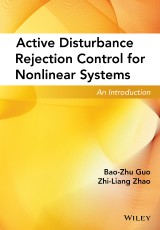Details

Active Disturbance Rejection Control for Nonlinear Systems
An Introduction1. Aufl.
|
117,99 € |
|
| Verlag: | Wiley |
| Format: | |
| Veröffentl.: | 18.10.2016 |
| ISBN/EAN: | 9781119239956 |
| Sprache: | englisch |
| Anzahl Seiten: | 368 |
DRM-geschütztes eBook, Sie benötigen z.B. Adobe Digital Editions und eine Adobe ID zum Lesen.
Beschreibungen
<p><i><b>A concise, in-depth introduction to active disturbance rejection control theory for nonlinear systems, with numerical simulations and clearly worked out equations</b></i></p> <ul> <li>Provides the fundamental, theoretical foundation for applications of active disturbance rejection control</li> <li>Features numerical simulations and clearly worked out equations</li> <li>Highlights the advantages of active disturbance rejection control, including small overshooting, fast convergence, and energy savings</li> </ul>
<p>Preface ix</p> <p><b>1 Introduction 1</b></p> <p>1.1 Problem Statement 1</p> <p>1.2 Overview of Engineering Applications 6</p> <p>1.3 Preliminaries 9</p> <p>1.3.1 Canonical Form of ADRC 9</p> <p>1.3.2 Stability for Nonlinear Systems 18</p> <p>1.3.3 Stability of Linear Systems 24</p> <p>1.3.4 Finite-Time Stability of Continuous System 27</p> <p>1.3.5 Stability of Discontinuous Systems 32</p> <p>1.3.6 Proof of Theorem 1.3.11 34</p> <p>1.4 Remarks and Bibliographical Notes 50</p> <p><b>2 The Tracking Differentiator (TD) 53</b></p> <p>2.1 Linear Tracking Differentiator 55</p> <p>2.2 Nonlinear Tracking Differentiator 59</p> <p>2.2.1 Second-Order Nonlinear Tracking Differentiator 60</p> <p>2.2.2 High-Order Nonlinear Tracking Differentiator 64</p> <p>2.3 Finite-Time Stable System-Based Tracking Differentiator 69</p> <p>2.3.1 Convergence of Finite-Time Stable System-Based TD 70</p> <p>2.3.2 A Second-Order Finite-Time Stable Tracking Differentiator 75</p> <p>2.4 Illustrative Examples and Applications 77</p> <p>2.4.1 Comparison of Three Differentiators 77</p> <p>2.4.2 Applications to Frequency Online Estimation 81</p> <p>2.4.3 Application to the Boundary Stabilization of Wave Equation 85</p> <p>2.5 Summary and Open Problems 88</p> <p>2.6 Remarks and Bibliographical Notes 89</p> <p><b>3 Extended State Observer 93</b></p> <p>3.1 Linear Extended State Observer for SISO Systems 94</p> <p>3.2 Nonlinear Extended State Observer for SISO Systems 100</p> <p>3.2.1 Nonlinear ESO for SISO Systems 101</p> <p>3.2.2 Some Special ESO 109</p> <p>3.3 The ESO for SISO Systems with Time-Varying Gain 119</p> <p>3.4 The ESO for MIMO Systems with Uncertainty 133</p> <p>3.4.1 ESO for Systems with Total Disturbance 133</p> <p>3.4.2 ESO for Systems with External Disturbance Only 141</p> <p>3.4.3 Examples and Numerical Simulations 144</p> <p>3.5 Summary and Open Problems 150</p> <p>3.6 Remarks and Bibliographical Notes 153</p> <p><b>4 The Active Disturbance Rejection Control 155</b></p> <p>4.1 Linear ADRC for SISO Systems 157</p> <p>4.1.1 Global Convergence of Linear ADRC for SISO Systems 157</p> <p>4.1.2 Global Convergence for Systems with External Disturbance Only 167</p> <p>4.1.3 Semi-Global Convergence of LADRC 176</p> <p>4.1.4 Numerical Simulations 183</p> <p>4.2 Nonlinear ADRC for SISO Systems 187</p> <p>4.2.1 Global ADRC for SISO Systems with Total Disturbance 187</p> <p>4.2.2 Global ADRC for SISO System with External Disturbance Only 195</p> <p>4.2.3 Semi-global ADRC for SISO System with Vast Uncertainty 203</p> <p>4.2.4 Examples and Numerical Simulations 204</p> <p>4.3 ADRC with Time-Varying Tuning Parameter 206</p> <p>4.4 Nonlinear ADRC for MIMO Systems with Vast Uncertainty 228</p> <p>4.4.1 Semi-Global ADRC for MIMO Systems with Uncertainty 231</p> <p>4.4.2 Global ADRC for MIMO Systems with Uncertainty 238</p> <p>4.4.3 Global ADRC for MIMO Systems with External Disturbance Only 245</p> <p>4.4.4 Numerical Simulations 250</p> <p>4.5 IMP Versus ADRC 252</p> <p>4.6 HGC and SMC Versus ADRC 263</p> <p>4.7 Applications to PMSMs 267</p> <p>4.8 Application to Wave Equation with Uncertainty 270</p> <p>4.8.1 Control Design 271</p> <p>4.8.2 Proof of Theorem 4.8.1 279</p> <p>4.9 Summary and Open Problems 287</p> <p>4.10 Remarks and Bibliographical Notes 289</p> <p><b>5 ADRC for Lower Triangular Nonlinear Systems 291</b></p> <p>5.1 ESO for Lower Triangular Systems 291</p> <p>5.1.1 Constant High-Gain ESO 292</p> <p>5.1.2 Time-Varying Gain ESO 301</p> <p>5.1.3 Numerical Simulation 306</p> <p>5.2 Stabilization of Lower Triangular Systems by ADRC 312</p> <p>5.2.1 ADRC with Constant Gain ESO 313</p> <p>5.2.2 ADRC with Time-Varying Gain ESO 327</p> <p>5.3 Numerical Simulations 331</p> <p>5.4 Summary and Open Problems 336</p> <p>5.5 Remarks and Bibliographical Notes 338</p> <p>References 341</p> <p>Index 349</p>
<p><b>Bao-Zhu Guo</b>, Chinese Academy of Sciences, China; University of the Witwatersrand, South Africahas been working on control theory since his PhD studies in the Chinese university of Hong Kong from 1987-1991. His main expertise is in control theory for systems described by partial differential equations or infinite-dimensional systems. In this area, he has published over 160 articles in international journals and three books. In 1999, Prof. Guo was awarded the One Hundred Talent Program from the Chinese Academy of Sciences. Other honours include the National Science Fund for Distinguished Young Scholars (2003) from the National Natural Science Foundation of China and the One Hundred Talent Program from Shanxi Province, China (2009).</p> <p><b>Zhi-Liang Zhao</b>, Shaanxi Normal University, China is currently an associate professor in the Department of Mathematics. His research expertise is the convergence of active disturbance rejection control and is working on extending its application to more general nonlinear systems.</p>
Diese Produkte könnten Sie auch interessieren:

Strategies to the Prediction, Mitigation and Management of Product Obsolescence

von: Bjoern Bartels, Ulrich Ermel, Peter Sandborn, Michael G. Pecht

116,99 €
















